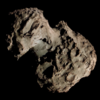C/1948 V1
| Discovery | |
|---|---|
| Discovery date | November 1, 1948 |
| Alternative designations | Eclipse Comet, 1948 XI, 1948 V1 |
| Orbital characteristics A | |
| Epoch | 2432840.5 |
| Aphelion | 3861 AU[1] |
| Perihelion | 0.135 AU |
| Semi-major axis | 1931 AU[1] |
| Eccentricity | 0.99994 |
| Orbital period | ~84,800 yr.[1] |
| Inclination | 23.1° |
| Last perihelion | October 27, 1948 |
| Next perihelion | unknown |
The Eclipse Comet of 1948, formally known as C/1948 V1, was an especially bright comet discovered during a solar eclipse on November 1, 1948. Although there have been several comets that have been seen during solar eclipses, the Eclipse Comet of 1948 is perhaps the best-known; it was however, best viewed only from the Southern Hemisphere.
When it was first discovered during totality, it was already quite bright, at magnitude -2; as it was near perihelion, this was its peak brightness.[2] Its visibility during morning twilight improved as it receded outward from the Sun; it peaked near zero magnitude, and at one point displayed a tail roughly 30 degrees in length, before falling below naked eye visibility by the end of December.[2]
References[]
- ^ a b c Horizons output. "Barycentric Osculating Orbital Elements for Comet C/2004 Q2 (Machholz)". Retrieved 2011-02-03. (Solution using the Solar System Barycenter and barycentric coordinates. Select Ephemeris Type:Elements and Center:@0)
- ^ a b Dr. Sten Odenwald. "When was the last time we had two bright comets in the same year?". Ask the Astronomer. Retrieved 2006-02-13.
External links[]
- Orbital simulation from JPL (Java) / Ephemeris
Categories:
- Cometary object articles
- Non-periodic comets
- 1948 in science
- Astronomical objects discovered in 1948
- Comet stubs

